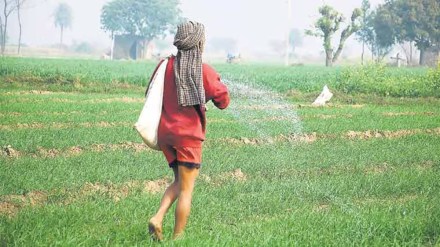The Commission for Agricultural Costs and Prices (CACP) has called for increasing urea prices in a phased manner to stem its excessive usage. This would not only help promote balanced use of soil nutrients but also rationalise the fertiliser subsidy outgo, explains Sandip Das.
l What did the CACP say?
While calling for a gradual increase in retail urea prices, the CACP, in its reports for the last Kharif and Rabi seasons, has termed the current fertiliser subsidy policy as ‘lopsided’, which substantially lowers the price of urea relative to phosphorus (P) and potassium (K) and complex fertilisers. The CACP recommended that after increasing urea prices in a phased manner, the resultant subsidy savings should be used for providing P & K fertilisers at an economical price to address the problem of nutrient imbalance in soils. The commission, which recommends minimum support price (MSP) for 23 crops to the government, in its earlier report for Kharif marketing season 2025-26, had observed that the ratio of N:P:K in usage of fertilisers was 10.9:4.4:1 during 2023-24 against the ideal ratio of 4:2:1. This distorted ratio is posing a serious threat to soil health, resulting in a persistent decline in crop response to fertilisers. Fertilisers are classified as sole fertilisers (includes urea and muriate of potash or MOP), mixed fertilisers (DAP and nitrogen, phosphorus and potassium or NPK), and those that contain micronutrients.
l Incentives to states for balanced use of fertilisers
Increasing urea prices is considered a politically sensitive issue, which the government has been reluctant to take the risk despite several proposals by experts for a calibrated hike in prices. Rather, the government has preferred to educate and encourage farmers towards balanced use of fertilisers based on soil health data. Fourteen states have reported a reduction of 1.51 million tonne (MT) in their combined fertiliser consumption in 2023-24 over the average in the previous three years. This has been achieved under the central scheme, PM Pranam, which incentivise states for balanced use of chemical nutrients. Under the scheme, 50% of the fertiliser subsidy saved by a state in a financial year by way of reduction in consumption of urea, DAP, NPK and MOP compared to the previous three years’ average consumption, is passed on as grant. In the three years prior to 2023-24, the annual consumption of fertilisers was around 58 MT.
l Price controls & subsidy bills
Since 2012, the retail urea price has been stuck at Rs 242 per 45 kg bag, even as the cost of production is over Rs 2,600 a bag. While the government covers the cost difference via subsidy to the manufacturers, the low retail price has led to overuse of urea, leading to decline in soil health. Over 62% of the fertiliser subsidy is allocated for urea.
On the other hand, retail prices of P and K fertilisers, including DAP, were ‘decontrolled’ in 2010 with the introduction of a ‘fixed-subsidy’ regime as part of the Nutrient Based Subsidy mechanism. So, fertiliser companies are dependent on the fixed subsidy announced bi-annually and can’t raise retail prices following any price spikes globally. This affects procurement viability. Global DAP prices are up by 23% since April while the retail price is stuck at Rs 1,350 per 50 kg bag for the last many years.
Fertiliser subsidy in FY25 was revised to Rs 1.91 lakh crore from the Budget estimate of Rs 1.68 lakh crore. For FY26, Rs 1.67 lakh crore has been allocated as subsidy.
l Rising import dependency
Along with deteriorating soil health, another impact of over-usage of urea is the rising import bill. While 87% of the annual urea demand —38.79 MT in FY25 — is met locally, India imports a significant volume of natural gas for making urea. Of the annual 10-11 MT of DAP demand, 60% is met through imports. Domestic manufacturing of DAP also depends on imported rock phosphate. Potash is 100% imported. In case of DAP, NPK and MOP, imports were 10.38 MT against the consumption of 21.12 MT. Experts say India’s fertiliser import dependence is over 90% if imports of raw materials are included. Entities such as National Fertilizers and Indian Potash (IPL) have floated tenders to import 2 MT of urea each. India has recently signed a long-term pact for supply of about 2 MT of fertilisers annually from Russia, Israel, Belarus and Jordan. In July, an agreement was signed between Saudi Arabia’s Maaden and Indian companies IPL, Kribhco and CIL for supply of 3.1 MT of DAP annually for five years, starting FY26.
l Need to open up fertiliser industry
The Fertiliser Ministry has been encouraging states to adopt alternate fertilisers and promote organic farming for reducing excessive use of chemical fertilisers which has led to deterioration of soil health. In addition, nano-fertilisers including nano-urea and nano-DAP are being promoted for reducing urea consumption although so far the outcome has been mixed. Application of these plant nutrients along with conventional applications could lead to up to 50% drop in usage of chemical fertilisers over the medium term, a senior official with The Energy Institute said.
Meanwhile, the government must also encourage the fertiliser industry to make strategic investments abroad — right from mining to finished products —by formulating a long-term policy. Currently, the subsidy regime works as a disincentive to fertiliser companies to ramp up production as well as imports.
